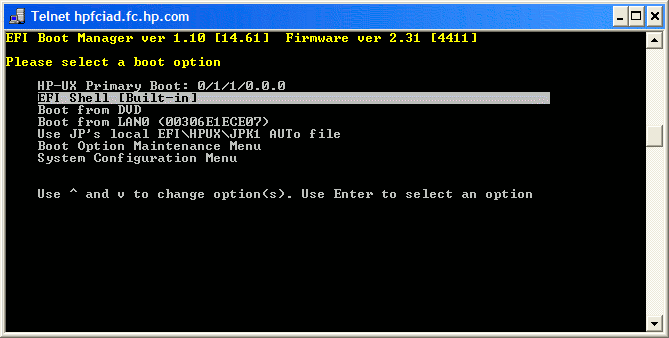

Subnet 192.168.1.0 netmask 255.255.255.0 /var/lib/tftp/images/rhv-4.3/Ĩ. Create a configuration file named grub.cfg in /var/lib/tftpboot.
#Boot from efi shell code
Option architecture-type code 93 = unsigned integer 16 Option pxelinux.reboottime code 211 = unsigned integer 32 Option pxelinux.pathprefix code 210 = text Option ms-classless-static-routes code 249 = array of integer 8

Option rfc3442-classless-static-routes code 121 = array of integer 8 Here is a sample configuration file based on the network diagram above: # DHCP Server Configuration File The third step is to create a boot entry for the Linux operating system in the EFI Boot Manager. The second step is to copy the EFI file to the EFI System Partition (ESP). Adjust the DHCP configuration file( /etc/dhcp/nf). The first step in booting Linux from an EFI file is to ensure that the EFI file is properly formatted.
#Boot from efi shell install
Install the DHCP server: # yum install -y dhcpĢ. Enabling the needed repositories: # subscription-manager repos -enable=rhel-7-server-rh-common-rpms -enable=rhel-7-server-rpms -enable=rhel-7-server-extras-rpmsīelow are the steps to set up the DHCP to support PXE boot for UEFI servers:ġ. Register and attach the system: #subscription-manager register -auto-attachĥ. #password for basic http proxy auth, if neededĤ. #user name for authenticating to an http proxy, if needed In the section below add the relevant details of the proxy server: #an http proxy server to use
#Boot from efi shell registration
RHEL7.6 ISO image is used to install the OS, with the minimal installation option.Īfter installation the OS registration and enabling the relevant repositories are needed:ġ. The server has one network interface card (NIC) which is used for all types of traffic, although you can have different network interfaces if network segregation is needed. The PXE server is installed on a server with four core CPUs and four GB of memory, although servers with lower specifications can work. The PXE server is setup on Red Hat Enterprise Linux (RHEL) 7.x. The PXE server can reach the internet via a proxy server, and if not then a Satellite server is used.ģ. Each servers' farm network has its own dedicated PXE network (called the "Provisioning Network" in this article), while the PXE server itself is not in any of these networks.īelow is the network diagram with sample IP ranges:Ģ. In this setup, we configure one PXE server and two different servers' farms. Setting up one PXE server to provision different servers' farms located in different networks is beneficial, especially if you are going to automate the provisioning later on. Setting up a PXE boot environment isn't particularly difficult but does require multiple critical steps and each step contains a lot of detail. In this article, I take you through the process of designing and setting up a Preboot Execute Environment (PXE) that includes setting up a PXE server, configuring a DHCP server, and installing a TFTP server. It is particularly handy to automate the process when there are slight differences between different hosts in the same network. Having Red Hat Virtualization (RHV) implemented in different networks requires some sort of automation to install new RHV hosts.


 0 kommentar(er)
0 kommentar(er)
